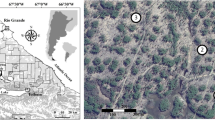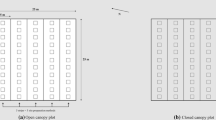Abstract
Context
Variable retention prescriptions for Nothofagus pumilio forests provide for biodiversity conservation and natural regeneration by controlled opening of the canopy. Harvesting generates different microenvironments which present dissimilar conditions for seedling establishment, due to positive or negative influences over biotic and abiotic factors.
Aims
This study evaluated seedling survival and performance in different microenvironments within the harvested stands. Tested hypotheses stated that seedling stress and performance were influenced by harvesting due to changes in forest structure, microclimate, soil properties, and nutrient availability.
Methods
In the stands harvested by variable retention, five contrasting microenvironments were selected as treatments for the experiments and sampling. Environmental variables were related to ecophysiological, seedling survival, and performance.
Results
The modification of forest structure (crown cover and tree density) and the presence of coarse woody debris greatly affect the effective rainfall and global radiation reaching understorey level, influencing seedling stress and consequently survival and performance. Harvesting also modifies soil properties (e.g., soil bulk density) and coarse woody debris accumulation which in turn influences soil moisture and/or solar radiation levels. Analyses showed that seedlings received benefits of microenvironment variation after harvesting. Areas covered with middle or fine woody debris presented regeneration with better ecophysiological response and seedling performance, although dispersed retention areas (far away from remnant trees) and roads could also present suitable conditions for seedling survival and performance.
Conclusions
The proportion of different microenvironments in the harvested forests will determine the amount of natural recruitment of regeneration and consequently the success of proposed silvicultural management. Forest practices must be manipulated to increase the proportion of favorable microenvironments (e.g., woody debris), allowing greater natural regeneration success during the first years after harvesting.







Similar content being viewed by others
References
Ammer C, Stimm B, Mosandl R (2008) Ontogenetic variation in the relative influence of light and belowground resources on European beech seedling growth. Tree Physiol 28:721–728
Blood LE, Titus JH (2010) Microsite effects on forest regeneration in a bottomland swamp in western New York. J Torrey Bot Soc 137:88–102
Bray RH, Kurtz LT (1945) Determination of total, organic, and available forms of phosphorus in soils. Soil Sci 59:39–45
Buckley D, Crow T, Nauertz E, Schulz K (2003) Influence of skid trails and haul roads on understory plant richness and composition in managed forest landscapes in Upper Michigan, USA. For Ecol Manage 175:509–520
Caldentey J, Ibarra M, Hernández J (2001) Litter fluxes and decomposition in Nothofagus pumilio stands in the region of Magallanes, Chile. For Ecol Manage 148:145–157
Caldentey J, Mayer H, Ibarra M, Promis A (2009) The effects of a regeneration felling on photosynthetic photon flux density and regeneration growth in a Nothofagus pumilio forest. Eur J For Res 128:75–84
Chen J, Franklin JF, Spies TA (1995) Growing-season microclimate gradients from clearcut edges into old-growth Douglas-fir forests. Ecol Appl 5:74–86
Chen J, Saunders SC, Crow TR, Naiman RJ, Brosofske KD, Mroz GD, Brookshire BL, Franklin JF (1999) Microclimate in forest ecosystem and landscape ecology. Bioscience 49:288–297
Cordeiro Y, Pinheiro H, dos Santos FB, Correa S, Silva J, Dias-Filho M (2009) Physiological and morphological responses of young mahogany (Swietenia macrophylla King) plants to drought. For Ecol Manage 258:1449–1455
Cuevas JG (2000) Tree recruitment at the Nothofagus pumilio alpine timberline in Tierra del Fuego, Chile. J Ecol 88:840–855
Fitter AH, Hay RK (2002) Environmental physiology of plants. Academic, London, p 397
Frangi J, Richter L (1994) Balances hídricos de bosques de Nothofagus de Tierra del Fuego, Argentina. Rev Fac Agron de La Plata 70:65–79
Frazer GW, Fournier RA, Trofymow JA, Gall RJ (2001) A comparison of digital and film fisheye photography for analysis of forest canopy structure and gap light transmission. Agric For Meteorol 109:249–263
Gustafsson L, Baker S, Bauhus J, Beese W, Brodie A, Kouki J, Lindenmayer D, Lõhmus A, Martínez Pastur G, Messier C, Neyland M, Palik B, Sverdrup-Thygeson A, Volney J, Wayne A, Franklin JF (2012) Retention forestry to maintain multifunctional forests: a world perspective. Bioscience 62:633–645
Gutiérrez E (1994) Els boscos de Nothofagus de la Terra del Foc com a paradigma de dinámica successional del no-equilibri. Treballs de la SCB 45:93–121
Heinemann K, Kitzberger T (2006) Effects of position, understorey vegetation and coarse woody debris on tree regeneration in two environmentally contrasting forests of north-western Patagonia: a manipulative approach. J Biogeogr 33:1357–1367
Heinemann K, Kitzberger T, Veblen T (2000) Influences of gap microheterogeneity on the regeneration of Nothofagus pumilio in a xeric old-growth forest of northwestern Patagonia, Argentina. Can J For Res 30:25–31
Heithecker TD, Halpern CB (2007) Edge-related gradients in microclimate in forest aggregates following structural retention harvests in western Washington. For Ecol Manage 248:163–173
Howard TM (1973) Studies in the ecology of Nothofagus cunninghamii Oerst. in natural regeneration on the Mt. Donna Buang Massif, Victoria. Aust J Bot 21:67–78
Kupferschmid AD, Bugmann H (2005) Effects of microsites, logs and ungulate browsing on Picea abies regeneration in a mountain forest. For Ecol Manage 205:251–265
Lencinas MV, Martínez Pastur G, Gallo E, Cellini JM (2011) Alternative silvicultural practices with variable retention to improve understory plant diversity conservation in southern Patagonian forests. For Ecol Manage 262:1236–1250
Lindenmayer D, Franklin JF, Lõhmus A, Baker S, Bauhus J, Beese W, Brodie A, Kiehl B, Kouki J, Martínez Pastur G, Messier C, Neyland M, Palik B, Sverdrup-Thygeson A, Volney J, Wayne A, Gustafsson L (2012) A major shift to the retention approach for forestry can help resolve some global forest sustainability issues. Conserv Let 5:421–431
Martínez Pastur G, Peri P, Vukasovic R, Vaccaro S, Piriz Carrillo V (1997) Site index equation for Nothofagus pumilio Patagonian forest. Phyton 6:55–60
Martínez Pastur G, Lencinas MV, Peri P, Arena M (2007) Photosynthetic plasticity of Nothofagus pumilio seedlings to light intensity and soil moisture. For Ecol Manage 243:274–282
Martínez Pastur G, Peri P, Cellini JM, Lencinas MV, Barrera M, Ivancich H (2011a) Canopy structure analysis for estimating forest regeneration dynamics and growth in Nothofagus pumilio forests. Ann For Sci 68:587–594
Martínez Pastur G, Cellini JM, Lencinas MV, Barrera M, Peri P (2011b) Environmental variables influencing regeneration of Nothofagus pumilio in a system with combined aggregated and dispersed retention. For Ecol Manage 261:178–186
Martínez Pastur G, Jordán C, Lencinas MV, Soler Esteban R, Ivancich H, Kreps G (2012) Landscape and microenvironmental conditions influence over regeneration dynamics in old-growth Nothofagus betuloides Southern Patagonian forests. Plant Biosyst 146:201–213
McCarthy J (2001) Gap dynamics of forest trees: a review with particular attention to boreal forests. Environ Rev 9:1–59
Modry M, Hubeny D (2003) Impact of skidder and high-lead system logging on forest soils and advanced regeneration. J For Sci 49:273–280
Neyland M, Hickey J, Read SM (2012) A synthesis of outcomes from the Warra silvicultural systems trial, Tasmania, Australia: safety, timber production, economics, biodiversity, silviculture and social acceptability. Aust For 75:147–162
Palik B, Mitchell RJ, Pecot S, Battaglia M, Pu M (2003) Spatial distribution of overstorey retention influences resources and growth of longleaf pine seedlings. Ecol Appl 13:674–686
Peri P, Martínez Pastur G, Lencinas MV (2009) Photosynthetic and stomatal conductance responses to different light intensities and water status of two main Nothofagus species of south Patagonian forest. For Sci 55:101–111
Rosenfeld JM, Navarro Cerrillo RM, Guzmán Alvarez JR (2006) Regeneration of Nothofagus pumilio (Poepp. et Endl.) Krasser forests after five years of seed tree cutting. J Environ Manage 78:44–51
Schmidt MG, Ogden AE, Lertzman KP (1998) Seasonal comparison of soil temperature and moisture in pits and mounds under vine maple gaps and conifer canopy in a coastal western hemlock forest. Can J Soil Sci 78:291–300
Soler Esteban R, Martínez Pastur G, Lencinas MV, Borrelli L (2012) Forage differential use between native and domestic herbivores in southern Patagonian Nothofagus forests. Agrofor Syst 85:397–409
ter Braak CJF, Šmilauer P (2002) CANOCO reference manual and CanoDraw for Windows. User’s guide: software for canonical community ordination. Version 4.5. Microcomputer Power, Ithaca, New York, USA
Wardle JA (1970) The ecology of Nothofagus solandri: 3. Regeneration. N Z J Bot 8:571–608
Acknowledgments
The authors gratefully thank the Centro Austral de Investigaciones Científicas, Ricardo Vukasovic of Servicios Forestales Consultancy, Los Cerros Ranch, and Kareken sawmill for their support during the completion of this work.
Funding
We acknowledge funding (2009–2011) by the MIA-CATIE project (Fondo de apoyo a proyectos de investigación en mitigación y adaptación al cambio climático en la gestión forestal sostenible).
Author information
Authors and Affiliations
Corresponding author
Additional information
Handling Editor: Andreas Bolte
Contribution of the co-authors
G. Martínez Pastur coordinates the research project, designs the experiments, and writes the paper together with P.L. Peri and M.G. Neyland. R. Soler Esteban and J.M. Cellini worked in the data taking and data analyses under the supervision of M.V. Lencinas, who conducted the statistical data analysis.
Rights and permissions
About this article
Cite this article
Pastur, G.J.M., Esteban, R.S., Cellini, J.M. et al. Survival and growth of Nothofagus pumilio seedlings under several microenvironments after variable retention harvesting in southern Patagonian forests. Annals of Forest Science 71, 349–362 (2014). https://doi.org/10.1007/s13595-013-0343-3
Received:
Accepted:
Published:
Issue Date:
DOI: https://doi.org/10.1007/s13595-013-0343-3




